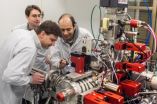(Press-News.org) Alexandria, VA — With over 37,000 face and neck injuries in more than 7,000 military personnel during Operations Iraqi Freedom (OIF) and Enduring Freedom (OEF), a new study in Otolaryngology–Head and Neck Surgery concludes additional training in the management of these injuries and improvements in body armor could be beneficial.
The authors note that OIF and OEF have changed the way military surgeons approach facial and penetrating neck trauma. "This study highlights the need for a trained head and neck surgeon in the deployed environment to address these changes and manage the high number of injuries," according to the authors.
The increased use of improvised explosive devices (IEDs) and improvements in body armor have led to an increase in facial injuries in proportion to other parts of the body, the authors state.
"Exposed body areas not covered by modern body armor are especially susceptible to multiple injuries from IEDS. Despite the technological advancements in body armor, a lightweight, comfortable yet effective face and neck shield has not yet been developed."
Data were collected from the Joint Theater Trauma Registry (JTTR) database, which contains information on all U.S. service members who were injured during OIF and OEF. Service member demographics, types and causes of injuries, intubations, surgical procedures, and other data were reviewed. The majority of those injured were in the Army (75%), with the Marine Corps, Navy, and Air Force at 20.5%, 2.5%, and 2.0%, respectively. Seventy-three percent of the injuries were incurred during OIF.
While males made up 97.5 percent of injured service members and the most common type of injury was penetrating, those least likely to survive their injuries were female and had blast injuries. Other risk factors were treatment at a level IIa facility and intubation before entering the hospital. Most face and neck injuries ranged from mild to moderate.
The authors also provide suggestions for training, treatment, and prevention of face and neck injuries. Tailoring the amount and kinds of training to the most commonly seen types of injuries and making sure surgeons are comfortable performing these surgeries, as well as designing body armor that better protects the face and neck, are important factors of survival.
This particular study "highlights the need for a trained head and neck surgeon in the deployed environment to address changes and manage the high number of injuries." The authors hope "that this study can help guide predeployment training for U.S. medical personnel who contribute to the management of patients with facial and penetrating neck trauma."
###
Otolaryngology–Head and Neck Surgery is the official scientific journal of the American Academy of Otolaryngology—Head and Neck Surgery Foundation (AAO-HNSF). The study's authors are Brent A. Feldt, MD; Nathan L. Salinas, MD; Todd E. Rasmussen, MD and Joseph Brennan, MD. Reporters who wish to obtain a copy of the study "The Joint Facial and Invasive Neck Trauma (J-FAINT) Project Iraq and Afghanistan 2003-2011" should contact Mary Stewart at 1-703-535-3762, or newsroom@entnet.org.
About the AAO-HNS
The American Academy of Otolaryngology—Head and Neck Surgery, one of the oldest medical associations in the nation, represents approximately 12,000 physicians and allied health professionals who specialize in the diagnosis and treatment of disorders of the ears, nose, throat, and related structures of the head and neck. The Academy serves its members by facilitating the advancement of the science and art of medicine related to otolaryngology and by representing the specialty in governmental and socioeconomic issues. The organization's vision: "Empowering otolaryngologist-head and neck surgeons to deliver the best patient care."
The Joint Facial and Invasive Neck Trauma (J-FAINT) Project, Iraq and Afghanistan 2003-2011
2013-03-05
ELSE PRESS RELEASES FROM THIS DATE:
Comparison investing: Why are consumers more willing to take risks when they can compare products?
2013-03-05
Consumers are more willing to take risks and accept delays in exchange for greater benefits when they are able to compare products, according to a new study in the Journal of Consumer Research.
"Rationally speaking, consumer preferences should be the same whether their product choices are presented side-by-side and evaluated comparatively or presented one at a time and evaluated in isolation, but it makes a remarkable difference in consumer decision-making," write authors Christopher K. Hsee (University of Chicago Booth School of Business), Jiao Zhang (University of Miami), ...
Targeting diet products: Why are more independent consumers better at delaying gratification?
2013-03-05
Product benefits that occur later in time are more likely to appeal to more independent consumers than to those who are more group or family oriented, according to a new study in the Journal of Consumer Research.
"More independent consumers think of the future in abstract terms and perceive future events as happening in the more distant future, whereas consumers who are less independent think of the future in concrete terms and perceive future events as happening sooner," write authors Gerri Spassova (Monash University) and Angela Y. Lee (Kellogg School of Management, ...
Texas A&M research contributes to improved ultrasound imaging
2013-03-05
Ultrasound technology could soon experience a significant upgrade that would enable it to produce high-quality, high-resolution images, thanks to the development of a new key material by a team of researchers that includes a professor in the Department of Biomedical Engineering at Texas A&M University.
The material, which converts ultrasound waves into optical signals that can be used to produce an image, is the result of a collaborative effort by Texas A&M Professor Vladislav Yakovlev and researchers from King's College London, The Queen's University of Belfast and ...
On the trail of mucus-eaters in the gut
2013-03-05
This press release is available in German.
The microbiology team of David Berry, Alexander Loy and Michael Wagner from the Faculty of Life Sciences, in collaboration with scientists at the Max F. Perutz Laboratories (University of Vienna and the Medical University of Vienna) and with the help of NanoSIMS technology, has for the first time succeeded in directly observing microorganisms feeding on the intestinal mucosa. The results of this research project appear in the current issue of the prestigious journal "Proceedings of the National Academy of Sciences" (PNAS).
To ...
Homes in neighborhoods with protected open space bringing higher sale prices
2013-03-05
Homes in neighborhoods that incorporate protected open space command prices 20 to 29 percent higher than those without open space, according to a new study by a Colorado State University multidisciplinary research team that included Wildlife Conservation Society scientist, Sarah Reed.
Conservation development is an approach to the design, construction, and stewardship of a development that protects natural resources while also providing social and economic benefits to people. The properties in this study specifically incorporated protected open space into the design of ...
A window into Europa's ocean lies right at the surface
2013-03-05
PASADENA, Calif.—If you could lick the surface of Jupiter's icy moon Europa, you would actually be sampling a bit of the ocean beneath. So says Mike Brown, an astronomer at the California Institute of Technology (Caltech). Brown—known as the Pluto killer for discovering a Kuiper-belt object that led to the demotion of Pluto from planetary status—and Kevin Hand from the Jet Propulsion Laboratory (JPL) have found the strongest evidence yet that salty water from the vast liquid ocean beneath Europa's frozen exterior actually makes its way to the surface.
The finding, based ...
U of M researchers find wide variation in cesarean delivery rates among US hospitals
2013-03-05
MINNEAPOLIS/ST. PAUL (March 4, 2013) – Cesarean delivery is the most common surgery in the United States, performed on 1.67 million American women annually. Yet hospital cesarean rates vary widely according to new research from the University of Minnesota's School of Public Health.
The latest study, appearing today in Health Affairs, shows that cesarean delivery rates varied tenfold across U.S. hospitals, from 7.1 percent to 69.9 percent.
To arrive at their results, School of Public Health researchers examined hospital discharge data from a representative sample ...
Survey of clinicians: User satisfaction with electronic health records has decreased since 2010
2013-03-05
March 5. 2013 -- Survey results released today indicate that satisfaction and usability ratings for certified electronic health records (EHRs) have decreased since 2010 among clinicians across a range of indicators. Overall, user satisfaction fell 12 percent from 2010 to 2012. Users who are "very dissatisfied" increased 10 percent during the same time period.
The American College of Physicians (ACP) and AmericanEHR Partners revealed the findings in a presentation, "Challenges with Meaningful Use: EHR Satisfaction & Usability Diminishing," at the 2013 HIMSS Conference ...
Hope in stopping melanoma from spreading: Inhibiting protein prevents metastasis to lungs in mice
2013-03-05
SALT LAKE CITY – Researchers have identified a critical protein role in the metastasis of melanoma, the most serious form of skin cancer. Inhibition of the protein known as adenosine diphosphate ribosylation factor 6 (ARF6) reduces the spread of melanoma to the lungs in mice, according to a study published in the March 5 issue of Science Signaling online, suggesting that targeting ARF6 may be an effective approach to preventing melanoma metastasis.
Melanoma is the sixth most common cancer in the United States. Approximately one in 50 people will develop melanoma in their ...
Researchers discover gene that causes obesity in mice
2013-03-05
AURORA, Colo. (March 5, 2013) – Researchers have discovered that deleting a specific gene in mice prevents them from becoming obese even on a high fat diet, a finding they believe may be replicated in humans.
"When fed a diet that induces obesity these mice don't get fat," said Prof. James McManaman, Ph.D., lead author of the study and vice-chairman of research for Obstetrics and Gynecology at the University of Colorado School of Medicine. "It may be possible to duplicate this in humans using existing technology that targets this specific gene."
The two-year study, ...


